Hi I am creating an Angular 2 app. It seems like the service is not getting injected correctly as I don't see the page showing any results. I have set the risk-list.component.html as the startup page. Could somebody tell me what the problem is ?
I have uploaded the code in a plunker as well
app.module.ts
import { NgModule } from '@angular/core';
import { BrowserModule } from '@angular/platform-browser';
import { AppComponent } from './app.component';
import { RiskListComponent } from './components/risks/risk-list.component';
@NgModule({
imports: [BrowserModule],
declarations: [AppComponent, RiskListComponent],
bootstrap: [AppComponent]
})
export class AppModule { }
app.component.ts
import { Component } from '@angular/core';
import { DataTable, Column } from 'primeng/primeng';
import { Router } from '@angular/router';
import { Routes, RouterModule } from '@angular/router';
import { WelcomeComponent } from './components/home/welcome.component';
import { RiskListComponent } from './components/risks/risk-list.component';
import { RiskDetailsComponent } from './components/risks/risk-detail.component';
import { ModuleWithProviders } from '@angular/core';
import './rxjs-operators';
import { RiskService } from './components/risks/risk.service';
@Component({
selector: 'my-app',
template: `
<div>
<h1>{{pageTitle}}</h1>
<rm-risks> </rm-risks>
</div>
<div>
<router-outlet> </router-outlet>
</div>
`
//,
//directives: [RiskListComponent, DataTable, Column],
})
export class AppComponent {
pageTitle: string = 'Test UK Trader';
}
const appRoutes: Routes = [
{ path: '/welcome', component: WelcomeComponent },
{ path: '/risks', component: RiskListComponent },
{ path: '/riskdetails', component: RiskDetailsComponent }
];
main.ts
import { platformBrowserDynamic } from '@angular/platform-browser-dynamic';
import { RiskService } from './components/risks/risk.service';
import { HttpModule, JsonpModule } from '@angular/http';
import './rxjs-operators';
import { enableProdMode } from '@angular/core';
import { AppModule } from './app.module';
const platform = platformBrowserDynamic();
platform.bootstrapModule(AppModule, [HttpModule, JsonpModule, RiskService]).catch(err => console.error(err));
risk-list.component.ts
import { Component, OnInit } from '@angular/core';
import { IRisk } from './risk';
import { RiskService } from './risk.service';
import { DataTable, Column } from 'primeng/primeng';
import {Header} from 'primeng/primeng';
import {Footer} from 'primeng/primeng';
import {Paginator} from 'primeng/primeng';
@Component({
selector: 'rm-risks',
//directives: [DataTable, Column, Header, Footer, Paginator],
templateUrl: '/app/components/risks/risk-list.component.html',
providers: [RiskService]
})
export class RiskListComponent {
pageTitle: string = 'Risk List';
errorMessage: string;
risks: IRisk[];
constructor(private _riskService: RiskService) {
this.risks = this._riskService.getRisks();
}
};
risk-list.component.html
<h3 class="first">{{pageTitle}}</h3>
<!--[rows]="5" [paginator]="true" [pageLinks]="2" [rowsPerPageOptions]="[5,10,20]"-->
<!--<p-paginator rows="10" totalRecords="100" pageLinkSize="3"></p-paginator>-->
<p-dataTable [value]="risks" [paginator]="true" rows="5" totalRecords="100" pageLinkSize="3" [rowsPerPageOptions]="[5,10,20]" [sortMode]="multiple" sortField="inceptionDate" [sortOrder]="1" >
<header>List of Risks</header>
<!--<footer>Choose from the list.</footer>-->
<p-column field="reference" header="Reference (contains)" [filter]="true" sortable="true"></p-column>
<p-column field="insuredName" header="Insured Name (contains)" [filter]="true" sortable="true"></p-column>
<p-column field="inceptionDate" header="Inception Date (contains)" [filter]="true" sortable="true"></p-column>
<p-column field="riskType" header="Risk Type (contains)" [filter]="true" sortable="true"></p-column>
<p-column field="status" header="Status (contains)" [filter]="true" sortable="true"></p-column>
<p-column field="grossPremium" header="Gross Premium (contains)" [filter]="true" sortable="true"></p-column>
<p-column field="allocatedTo" header="Allocated To (contains)" [filter]="true" sortable="true"></p-column>
<p-column field="allocatedCompany" header="Allocated Company (contains)" [filter]="true" sortable="true"></p-column>
</p-dataTable>
riskservice
import { Injectable } from '@angular/core';
import { IRisk } from './risk';
import { Http, Response } from '@angular/http';
import { Observable } from 'rxjs/Observable';
import 'rxjs/add/observable/from';
@Injectable()
export class RiskService {
//private _riskUrl = '/api/risks/risks.json';
//constructor(private _http: Http) { }
//getRisks(): Observable<IRisk[]> {
// return this._http.get(this._riskUrl)
// .map((response: Response) => <IRisk[]>response.json())
// .catch(this.handleError);
// }
//private handleError(error: Response) {
//}
//}
getRisks(): IRisk[] {
return [
{
"riskId": 1,
"reference": "HISC9308336",
"insuredName": "SA 84161",
"inceptionDate": "March 19, 2016",
"riskType": "Quote",
"status": "Indication",
"grossPremium": 100,
"allocatedTo": "Broker User",
"allocatedCompany": "Broker"
},
{
"riskId": 2,
"reference": "HISC9308340",
"insuredName": "Upper Loi",
"inceptionDate": "April 25, 2016",
"riskType": "Quote",
"status": "Indication",
"grossPremium": 312.22,
"allocatedTo": "Andy Marples",
"allocatedCompany": "Broker"
}
];
}
}
Application Structure
